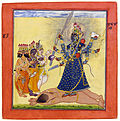Basohli | |
|---|---|
Town | |
| Coordinates: 32°30′N75°49′E / 32.50°N 75.82°E | |
| Country | |
| Union Territory | Jammu and Kashmir |
| District | Kathua |
| Elevation | 1,200 m (3,900 ft) |
| Population (2011) | |
• Total | 5,433 |
| Languages | |
| • Official | Dogri, Pahari, Hindi, English |
| Time zone | UTC+5:30 (IST) |
| Postal code | 184201 |

Basohli (formerly Vishwasthali) is the name of tehsil and town in Kathua district in the union territory of Jammu and Kashmir, India. It is situated on the right bank of the River Ravi, at an altitude of 1876 ft. The town was founded by Raja Bhupat Pal sometime in 1635. It was known for the palaces which are now in ruins and GI tagged Pahari miniatures paintings (the Basohli school of Pahari painting).
Contents
Basohli is known for its unique 'Basohli Paintings'. In the late 17th century, Basohli emerged as a great centre of Pahari paintings. According to well known Dr. Herman Goltz, "Basohli painting are among the great achievements of Indians". Their central inspiration is Vashnavism, the themes have been taken from the epics and the Puranas.
The different themes of the paintings are religious (Gita Govinda and Ramayana), secular, historical, contemporary and literary. Besides the paintings bring out extreme emotion combined with a lyrical sense of Basohli landscape.
Basohli paintings are said to have been described as 'Poems in colours'. The paintings are marked by strikingly blazing colours bold lines, rich symbols and peculiar features giving an accumulative impact of highly sensuous environs.






